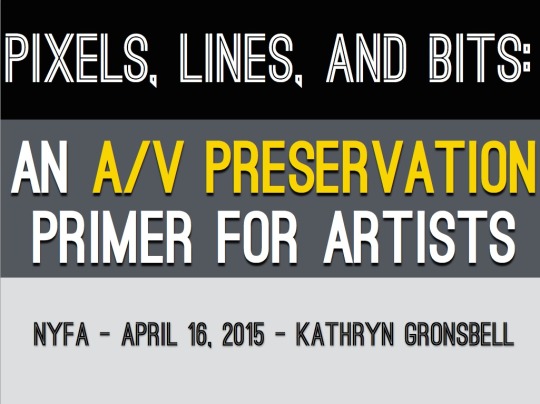HIGHLIGHT REEL FROM PIXELS, LINES AND BITS: AN A/V PRESERVATION PRIMER FOR ARTISTS
Top tips from Preservation Consultant Kathryn Gronsbell
If you were unable to join us for Kathryn Gronsbell’s awesome presentation about digital preservation procedures for artists and filmmakers, you can still access the goodies! Gronsbell generously shared the slides which you can access here. During her live presentation, Gronsbell’s passion for digital preservation shined through as she demonstrated the relevance of seemingly boring chores like “backing-up” and creating a database of work. By framing preservation as important investment in the careers of media makers, Gronsbell helped the audience understand how strong archives and preservation allow future collectors to intimately understand a creator’s intent.
Interested in learning more? Check out these highlights from Pixels, Lines and Bits:
1. What is A/V Preservation anyway? A/V preservation is anything done to ensure the INTEGRITY, AUTHENTICITY and USABILITY of a work. Creating accessible archives does not just need to happen through museums or private collections. In fact, individuals can take ownership of their materials by creating a database to keep archive records and digitally preserving their work. Doing so helps artists and filmmakers create new work, modify existing work and manage past work. It also increases accessibility should their collection be accrued in the future.
2. Metadata is key! Everything and anything produced in the digital realm has metadata – text messages, videos, images, and music all contain and are surrounded by different types of metadata (“data about data”) that needs to be managed and saved along with the work itself.
3. Not IF But WHEN…. Preservation is an ongoing process. Fact. It does not matter whether your office is blockaded with hard drives or you are not yet using a system. Technology is not static and as a result best practices for digital preservation are constantly evolving. The fabulous news is that artists and filmmakers can work backwards to prepare and thus minimize emergencies like losing valuable work. Here are some suggestions to get you started:
– Create AT LEAST three copies of your data. However, it is not recommended to put more resources into additional copies (3+) instead of allocating those resources into other things like better types of media (servers vs. removable hard drives) or geographically separating the redundant copies.
– Diversify the type and location of your redundant copies. Mixing methods of storage, for example hard drives and cloud storage, creates more opportunities for your work to exist. Making sure that your redundant copies are stored in different geographic areas increases your odds that a disaster in a specific geographic location does not result in the loss of all copies.
– If your preservation options include removable hard drives, purchase them at different times and locations in order to buy from different serial batches to avoid defects.
– Create a regular schedule for backing-up hard drives and storage. Sound annoying? Try integrating this into a routine of already existing maintenance or use a software application that automates the process.
– The current life of a hard drive is three to five years—maximum.
– CDs and DVDs can be problematic for individuals pursuing preservation of their work, even the discs marked ‘archival’. Optical media disallows the types of access and automated management that digital preservation requires, and are also very resource intensive to access for management, use for access and migration to new digital storage as it becomes available.
4. You Are Not Alone! Do you spend time bemoaning the pitfalls of old video codecs? Are you seeking lids for canisters of 16mm? Have you been carting around a box of degrading cassette tapes? Do not fear! Digital media preservation may sound overwhelming, but as Gronsbell demonstrated, it simply does not have to be. Grappling with archives preservation and archives is something ALL individual artists and filmmakers experience! As a result, there are fabulous tools, resources and communities to help you get started. Check out the Independent Media Arts Preservation and Association of Moving Image Archivists listed on the ‘Resources’ slide of Gronsbell’s presentation to connect with others.
–
Madeleine Cutrona, Fiscal Sponsorship Intern
Special thanks to Independent Media Arts Preservation (IMAP) for partnering with NYFA to make this event possible.



